The Perfect Light: When to Shoot
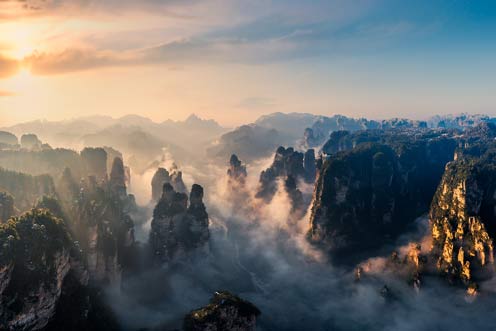
Golden Hours
The first and last hours of sunlight create magical conditions in Zhangjiajie. The low-angled sun casts long shadows across the landscape, creating depth and dimension among the stone pillars. The warm light accentuates the orange and red tones in the sandstone, while the valleys often fill with mist, creating an ethereal atmosphere.
Pro Tip: During summer, sunrise can be as early as 5:30 AM. Plan to arrive at your chosen location at least 30 minutes before sunrise to set up. Popular sunrise spots like Tianzi Mountain can get crowded, so arrive early to secure a good position.
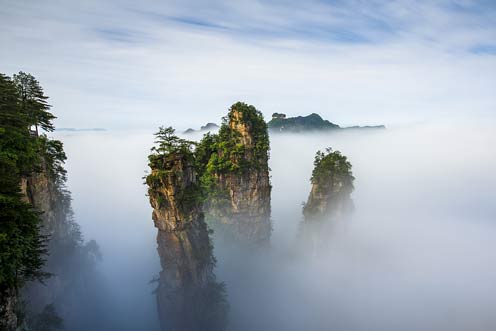
The Mist and Cloud Sea
Zhangjiajie is famous for its "sea of clouds" phenomenon, where mountain peaks appear to float above a blanket of clouds. This occurs most frequently in the early morning, especially after rainfall or during the change of seasons (spring and autumn). Dawn is the optimal time to capture this magical effect, particularly from elevated viewpoints.
Best Locations: Tianzi Mountain, Yangjiajie Scenic Area, and Laowuchang viewing platform offer excellent vantage points for capturing the sea of clouds effect. Check weather forecasts for humidity levels above 80% for the best chance of mist formation.
Seasonal Photography Guide
| Season | Photographic Highlights | Challenges | Tips |
|---|---|---|---|
| Spring (Mar-May) |
|
|
|
| Summer (Jun-Aug) |
|
|
|
| Autumn (Sep-Nov) |
|
|
|
| Winter (Dec-Feb) |
|
|
|
Prime Photography Locations
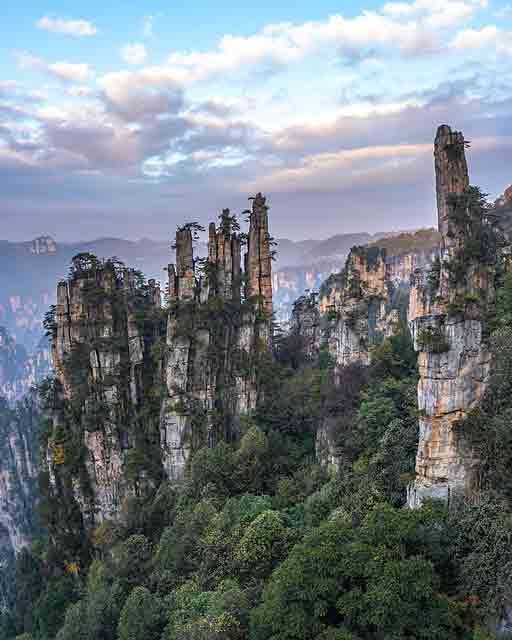
Tianzi Mountain
Elevation: 1,262m | Best time: Early morning or late afternoon
Known for its spectacular "sea of clouds" phenomenon, Tianzi Mountain offers panoramic views of hundreds of stone peaks emerging from the mist. The viewing platforms here provide some of the most iconic shots of Zhangjiajie's landscape.
Photography Tips:
- Arrive before sunrise for the best chance to capture the sea of clouds
- Use a wide-angle lens (16-35mm) to capture the expansive views
- Include people for scale to emphasize the enormity of the landscape
- The West Sea Stone Forest area offers the most dramatic compositions
Best Viewpoints: Helong Park, Imperial Brush Peak, and West Sea Stone Forest
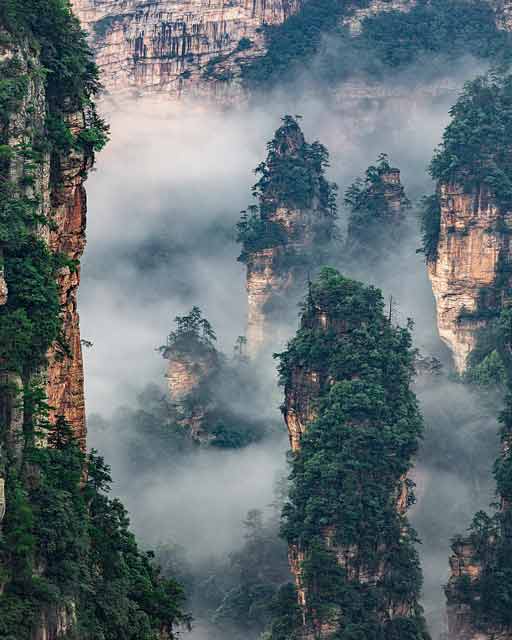
Yuanjiajie Scenic Area
Elevation: 1,074m | Best time: Morning (8-10am)
Home to the famous "Avatar Hallelujah Mountain" (officially Southern Sky Column), Yuanjiajie offers incredible opportunities to photograph the floating mountains that inspired the film Avatar. The area features several natural platforms perfect for photography.
Photography Tips:
- Use a telephoto lens (70-200mm) to isolate and compress the stone pillars
- Visit on slightly foggy days for the most atmospheric shots
- The Platform of Forgetfulness offers excellent composition opportunities
- Try to arrive early, as this area gets extremely crowded by midday
Best Viewpoints: First Bridge Under Heaven, Mihun Stage (Lost Souls Platform), and Avatar Hallelujah Mountain viewpoint
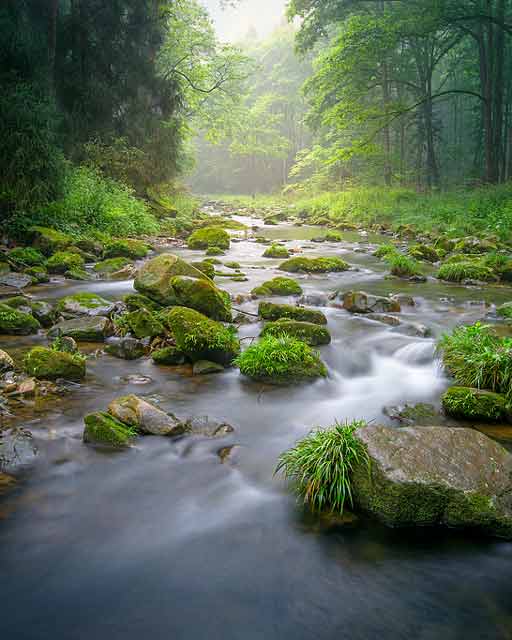
Golden Whip Stream
Elevation: Valley floor | Best time: Late morning to early afternoon
This picturesque stream offers a completely different perspective from the ground level. The 7.5km trail follows a crystal-clear stream flanked by towering peaks, creating endless opportunities for intimate landscape photography.
Photography Tips:
- Use a polarizing filter to reduce reflections on the water surface
- Bring a tripod for longer exposures to smooth the flowing water
- Look for natural frames created by overhanging trees and rock formations
- This area offers good lighting even during midday due to the valley shadows
Best Spots: The red stone wall area, the stepping stones across the stream, and any section where peaks are visible above the forest canopy
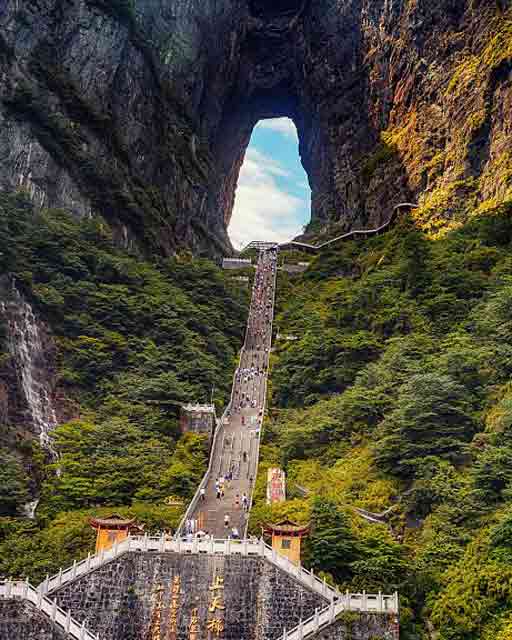
Tianmen Mountain
Elevation: 1,518m | Best time: Late afternoon
Separate from the main park, Tianmen Mountain features the famous "Heaven's Gate" natural arch, glass walkways hugging cliff sides, and the world's longest cable car. The diverse features create unique photographic opportunities unlike anywhere else in the region.
Photography Tips:
- Use a wide-angle lens for the glass walkway shots (capture both the path and the drop)
- For Heaven's Gate, climb to the top of the stairs for the best composition
- The cable car journey offers excellent aerial photography - keep your camera accessible
- Golden hour lighting on the mountain temple is particularly photogenic
Best Viewpoints: The 999-step stairway to Heaven's Gate, the West Glass Walkway, and the temple complex at the summit
Essential Photography Equipment
Camera Gear
-
Weather-sealed camera body
The high humidity and occasional rain make weather sealing essential for protecting your equipment.
-
Versatile zoom lenses
A wide-angle zoom (16-35mm) and a telephoto zoom (70-200mm) will cover most situations. The wide-angle captures expansive landscapes, while the telephoto isolates distant peaks and compresses the unique formations.
-
Sturdy but lightweight tripod
Essential for low-light conditions and long exposures, but you'll be carrying it up many stairs, so balance weight and stability.
-
Circular polarizing filter
Helps manage reflections from foliage and water, enhancing colors and reducing haze.
Accessories & Protection
-
Extra batteries and memory cards
Limited charging opportunities in the park make spare batteries essential. The photogenic landscape will fill memory cards quickly.
-
Lens cleaning kit
The humid environment means frequent lens fogging. Carry microfiber cloths and a rocket blower to keep optics clean.
-
Rain cover for camera and bag
Sudden rain showers are common. A dedicated rain cover or even a plastic bag with a hole cut for the lens can save your equipment.
-
Silica gel packets
Place these in your camera bag to help manage humidity and prevent fungus growth on lenses.
-
Comfortable camera backpack
You'll be hiking extensive distances and climbing many stairs. A comfortable backpack with good weight distribution is essential.
Advanced Techniques for Zhangjiajie
Capturing the Mist
The famous mist that weaves between the stone pillars can be challenging to photograph effectively:
- Expose for the highlights to preserve the delicate details in the mist
- Use spot metering on a mid-tone area for the most balanced exposure
- Consider bracketing exposures (3-5 shots at different exposures) to blend later
- Early morning backlighting can create dramatic rays through the mist
Scale and Perspective
Conveying the massive scale of Zhangjiajie's landscape is one of the biggest challenges:
- Include human elements (people on viewing platforms) to show scale
- Use telephoto compression to emphasize the layered mountains
- Photograph during golden hour when shadows create texture and depth
- Use leading lines (pathways, railings) to draw the eye through the scene
Long Exposure Techniques
Long exposures can enhance moving elements in the landscape:
- Use ND filters for daytime long exposures of moving clouds around peaks
- For waterfalls, exposures of 1/4 to 1 second create silky water effects
- During blue hour, try 20-30 second exposures to capture light trails from cable cars
- Use your camera's timer or a remote release to prevent camera shake
Weather Challenges
Working with Zhangjiajie's variable weather conditions:
- Embrace changing weather rather than fighting it - dramatic clouds can enhance compositions
- Check for condensation when moving between temperature extremes
- Keep lens caps off but covered when transitioning from air-conditioned areas to humidity
- After rain, look for reflecting pools that can create mirror images of the pillars